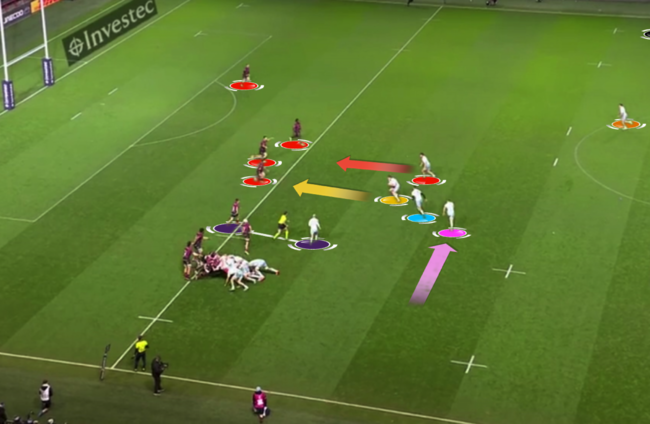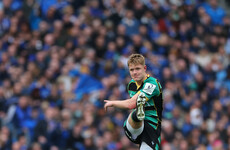THE GAME IS still tied at 7-7 when Leinster get a scrum on the left-hand side of Bristol’s 22-metre line.
The first thing to note is that Bristol have eight forwards in the scrum against Leinster’s seven.
The visitors don’t have a player in the openside flanker slot.
That’s because referee Pierre Brousset sin-binned Leinster loosehead Andrew Porter and Bristol tighthead Max Lahiff a few minutes earlier at a scrum.
With another scrum immediately being set, both sides needed to send on props to ensure the set-piece could remain contested.
Leinster sent loosehead Jack Boyle back on, temporarily replacing back row Jack Conan. But Bristol opted to temporarily replace their outside centre, Kalaveti Ravouvou, with tighthead prop Lovejoy Chawatama.
That means eight-versus-seven in the scrum in Bristol’s favour, but also means they now have to defend with one back fewer than Leinster.
They’ve already had to rejig their backline due to an early injury for out-half AJ MacGinty, with centre Benhard Janse van Rensburg [12 above] moving to out-half and replacement centre Joe Jenkins [22] coming in on in midfield.
With Ravouvou now temporarily off the pitch, left wing Gabriel Ibotoye [11] defends in the outside centre channel.
Not only do Bristol now only have two back three players to defend with [14 and 15], they also have an unfamiliar midfield combination. Leinster exploit the situation perfectly.
The ball is in and out of the scrum as quickly as possible, negating the danger of scrummaging with one player fewer.
This is a quick set-piece but props Boyle and Thomas Clarkson do a fine job as hooker Rónan Kelleher focuses on a swift strike down ‘channel one’ close to the feed.
It means scrum-half Jamison Gibson-Park can rapidly regather the ball and scoot away from the scrum, offering a brief run threat before he passes.
Gibson-Park’s dart also means he can get more length on his pass to Leinster inside centre Jordie Barrett [23], which essentially removes Bristol scrum-half Harry Randall [9 below] from the defensive equation.
In an ideal world, Randall would be able to get away from the scrum to cover Barrett, allowing the other Bristol defenders to shift one man wider each, but Gibson-Park’s movement and fizzing pass mean Randall can’t.
That in turn means Barrett can run directly at van Rensburg [12 above], forcing him to sit down in the defensive line, which has a knock-on effect on the defenders outside him.
Barrett [yellow below] is the fulcrum of Leinster’s play and the threat of his ball-carrying is a worry for Bristol, but there are many other options to consider.
Outside centre Robbie Henshaw [red above] has started to run a short, hard line to Barrett’s right as out-half Sam Prendergast [blue] begins to bounce out the back, while left wing Jordan Larmour [pink] is also swinging out to Leinster’s right.
Wider in the Leinster backline is fullback Jimmy O’Brien [orange] while right wing Garry Ringrose [black] is out of shot on the right touchline.
What’s key here is that Barrett [yellow below] engages van Rensburg in front of him as Henshaw [red] does the same to Jenkins.
The Leinster pair do a great job of sitting van Rensburg and Jenkins down, with Barrett running square at the line and giving no cues as to whether he will carry, pass short to Henshaw, or go out the back to Prendergast.
Meanwhile, Larmour [pink below] has accelerated hard across the pitch to start getting on the outside of Prendergast, which means Ibitoye [11] is under pressure before Barrett even passes out the back to Prendergast.
With Henshaw running hard at Jenkins, the Bristol centre is going to struggle to push off Henshaw and plug Ibitoye’s inside shoulder.
Ibitoye can see Larmour swinging to Prendergast’s outside, so now Larmour is becoming a threat to Ibitoye’s outside shoulder.
It’s also worth noting that because Larmour starts behind the Leinster scrum, he is initially a threat down the shortside along with Gibson-Park, which means that Randall [9 below] and Bristol right wing Jack Bates [14] have to initially cover that possibility.
Returning to how the play unfolds, Bristol are in trouble.
With Barrett pulling his pass out the back to Prendergast at the last split second, Ibitoye is now in a seriously tough spot, with Leinster having isolated him.
Henshaw [red above] has interested Jenkins and gets a slight nudge on him even as the Bristol centre tries to push out beyond Henshaw.
Prendergast [blue] has the ball cocked as if to pass to Larmour [pink], who is a clear danger on Ibitoye’s outside, while Bristol fullback Richard Lane [orange] remains concerned about O’Brien and Ringrose out wider.
Even as Prendergast receives the ball and runs at the line, Ibitoye is still hoping Jenkins can get past Henshaw to the Leinster out-half, who further encourages Ibitoye to drift out onto Larmour by throwing a dummy pass.
Prendergast accelerates into the hole between Jenkins and Ibitoye, the ball going into his right arm as he turns on the speed and gets away from Jenkins’ despairing stretch.
Prendergast is calm once he gets in behind Bristol, finishing the first-phase try smartly.
Bates is covering across in the backfield and he can see that Randall has continued to chase across from his starting position at the scrum.
Bates can clearly see that Prendergast has three team-mates outside him, making it a clear-cut try-scoring chance.
That means Bates is hoping Randall can get to Prendergast, which would allow Bates to drift off onto Larmour to at least force Leinster into an extra pass.
Prendergast shows good awareness as he glances back to his left, assessing Bates’ positioning but quite possibly picking up Randall in his peripheral vision too.
Both Bristol players understandably anticipate a pass from Prendergast here.
And he plays on that by getting the ball back into two hands and throwing a second dummy to con both of them.
Not only does Bates jockey off Prendergast and out towards Larmour, but Randall also reacts to the dummy by ever-so-slightly adjusting out to his right anticipating the pass.
That allows Prendergast an extra sliver of time and space to straighten up and continue accelerating through under the posts.
It’s a clinical first-phase try and sets in motion a period of near-total Leinster dominance that yields a further two tries in the following five-and-a-half minutes.
At 28-7, it’s game over.





























Great to break things down in detail as usual Murray! I felt like Jordie Barrett really made a difference and seems to be able to slot in where needed in a strong backline!
@Donal Peoples: His availability and work at first receiver is what creates the try… but Murray breaks down the work of JGP too and it is intelligent from the 9
Super analysis again Murray! The minutia, illustrated in such detail, educates the ranks of enthusiastic dilettantes- such as self! Kudos!
@declanbreen: Not when there are Yellow Cards involved, only where scrum is uncontested due to lack of front-row players.
Do you not have to have 8 in the scrum?
@declan breen: Up to U19s (which includes J2) the team down a player must match numbers in the scrum. J1 or above, including professional rugby, they do not have to match unless there is uncontested scrums.
@Paul Ennis: True regarding u19, albeit with a nuance that often gets missed: at u19 you only subtract players, never add. (E.g., if red team forward is yellow carded, blue team must also remove a forward in their scrum (though he can join the backlone)). You alo pull 8m forst, etc. to keep the scrum balanced. It’s a safety issue: you don’t want untrained backs coming into the scrum.